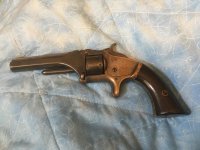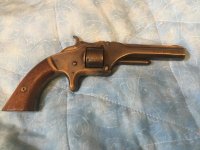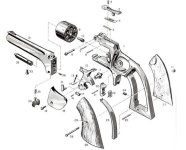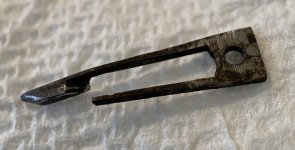Green Frog
Member
First, I’m aware that condition of this piece does not “make the cut” as a desirable antique BUT, it does get points for its history and provenance. As the title said, it a beat up example of a No 1, 2nd issue, serial number 43298. It’s been in my family since the late 1890s when my great grandfather brought it home to his young son (my grand uncle). It had been found in a ditch by the road and was filthy and missing its right grip panel. Uncle Raymond already showed a budding interest in machinery and guns. Over time he cleaned it up, made and fitted the replacement grip, and reblued the barrel and cylinder. The replacement of the worn plating was beyond his skills. So the brass shows through its nearly absent cover.
Mechanically, it has what is most charitably described as a “poor” bore but is otherwise actually shootable except when the hammer is cocked, the cylinder rolls past locked before it stops. I can then turn it back slightly until it clicks into locked position. At this point it functions correctly.
My antique S&W smithing skills are less than rudimentary, so I’m hoping someone can suggest what is wrong and how it can be corrected. I want to make my late Uncle Raymond proud! TIA for all help.
Green Frog
Mechanically, it has what is most charitably described as a “poor” bore but is otherwise actually shootable except when the hammer is cocked, the cylinder rolls past locked before it stops. I can then turn it back slightly until it clicks into locked position. At this point it functions correctly.
My antique S&W smithing skills are less than rudimentary, so I’m hoping someone can suggest what is wrong and how it can be corrected. I want to make my late Uncle Raymond proud! TIA for all help.
Green Frog
Attachments
Last edited:




